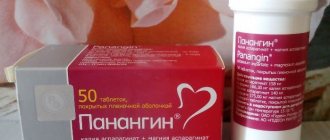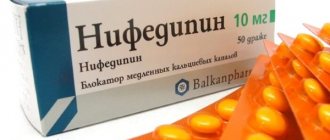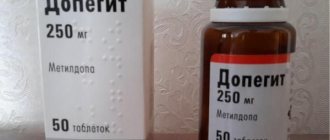For high blood pressure, drug therapy plays an important role. With the help of properly selected medications, the doctor can improve the patient’s general condition, lower blood pressure, and eliminate the likelihood of a hypertensive crisis and other undesirable consequences for the body. The drug Methyldopa belongs to the pharmacological group of alpha-adrenergic agonists. The drug has a pronounced hypotensive effect. You can take the medicine only as prescribed by your doctor, who determines the dosage and duration of therapy.
Information about the drug
Latin name of the substance
Methyldopa
Chemical name
3-Hydroxy-alpha-methyl-L-tyrosine
Release form
The drug is produced in the form of tablets and solution for injection. The drug is produced from a whitish or yellowish powder without any foreign odor. The powder dissolves well in water.
pharmachologic effect
Hypotensive. Methyldopa lowers blood pressure.
Packaging of Methyldopa tablets
Terms of sale
The drug is sold in pharmacies with a doctor's prescription.
Storage conditions
The drug must be stored in a place protected from children. The storage temperature for the solution is 15-25 degrees. Tablets are stored at room temperature.
The shelf life of the drug in tablets is 3 years, the solution can be stored for 5 years. Other information about storage conditions and permitted periods of use are specified in the instructions for use of Methyldopa.
Features of the drug
"Dopegit" is a Hungarian medicine from the group of antihypertensive drugs that have a central effect. It comes in the form of tablets, which are sold in brown glass bottles of 50 pieces. They are greyish-white in color and flat, round in shape, have no particular smell or taste, and are marked "DOPEGYT" on one side.
The effect of such tablets on the human body is due to an ingredient called methyldopa. Its dosage in one tablet is 250 mg. Additionally, the product contains substances that create a dense texture. These are ethylcellulose, stearic acid, corn starch and some other compounds.
To purchase medicine at a pharmacy, you need a prescription from a doctor. The average price of one bottle of Dopegit is 200 rubles. The product should be stored at home in a place hidden from small children. The recommended storage temperature is no higher than 25 degrees Celsius, and the shelf life of such tablets is 5 years.
Pharmacodynamic and pharmacokinetic characteristics
The drug Methyldopa affects the receptors responsible for regulating blood pressure. Methyldopa lowers blood pressure through alpha-adrenergic receptors, which are located in the plasmalemma of the neurons of the cerebral bulb.
Under the influence of the drug, vascular resistance and blood pressure levels decrease. The components of the drug increase the hemodynamics of the kidneys, accelerating the glomerular filtration rate. The drug reduces the active activity of renin. the content of dopamine, serotonin, and epinephrine decreases.
With prolonged use of the drug, the mass of the left ventricular myocardium decreases and the concentration of collagen in the heart increases.
Taking the first Methyldopa tablet or injection may cause a short-term increase in blood pressure. The effectiveness of the drug decreases with increased physical activity. The drug slows down the sinus rhythm, retains water and sodium ions in the body, and leads to the activity of interoreceptors. You need to stop taking Methyldopa gradually, as the drug causes a withdrawal reaction.
Methyldopa has a calming effect on the nervous system for high blood pressure. The sedative effect decreases two weeks after the start of the Methyldopa course. Blood pressure levels begin to decrease within 5 hours after administration. The effect of one tablet lasts for 1-2 days. With intravenous administration of Methyldopa solution, the pressure decreases after 3 hours. The maximum hypotensive effect is achieved 4 hours after injection. The injection lasts for 10 hours.
The tablets are taken orally. After taking the tablet, it breaks down into enzymes under the influence of gastric juice. Bioavailability is 50%. The maximum content of active components is observed after 2-6 hours.
Mechanism of action of alpha adrenergic agonists
The components of the drug penetrate the central nervous system, about 10% of the substances undergo breakdown and decarboxylation to dopamine and norepinephrine. Binding to blood proteins is only 20%.
About 70% of metabolites are excreted through the kidneys. Almost 90% of the components of the drug are eliminated within the first two hours after administration. The half-life is 90-100 minutes. It will take more than a day and a half to completely remove the components from the body.
In severe renal failure, the half-life increases. Impaired liver function leads to the slow disintegration of the tablet into components.
With long-term use, an accumulative effect is observed. Residues of the drug can be removed from the body by hemodialysis and peritoneal dialysis.
Drug interactions
It is not recommended to combine methyldopa with sympathomimetics (phenamine, ephedrine), as peripheral vascular spasm and increased blood pressure may develop.
When taken simultaneously with iron supplements, the absorption of methyldopa is significantly reduced.
The simultaneous use of:
- with tricyclic antidepressants;
- phenothiazine;
- non-steroidal anti-inflammatory drugs (Ibuprofen, Indomethacin, Diclofenac);
- estrogen preparations.
The simultaneous use of methyldopa and levodopa reduces the antiparkinsonian effect of the latter. Bleeding may occur while taking anticoagulants. Consumption of alcohol and methyldopa leads to significant depression of nervous system function.
Instructions for use and dosage for arterial hypertension
The drug in tablet form is intended for oral administration. The dosage, duration of therapy, and frequency of administration are determined by the attending physician according to indications.
The initial daily dosage of Methyldopa for blood pressure is 250 mg. Doctors recommend taking the first tablet before bed. The dosage is gradually increased: every two days the dose is increased by 250 mg. The maximum daily dosage is 3 grams. The dosage is divided into several doses.
When the required antihypertensive effect is achieved, the dose is adjusted, gradually reducing to 250 mg every two days.
In old age, when dealing with high blood pressure, Methyldopa should be taken in minimal dosages. The initial dosage is 125 mg every two days. The maximum dose is 2 grams, divided into two doses.
For children, the dosage to reduce blood pressure is prescribed based on body weight. For 1 kg of weight you need to take 10 mg of the drug. The daily dose is divided into 2 or 4 doses. the maximum dosage in childhood is 65 mg per 1 kg of body weight.
Doctors recommend taking the first Methyldopa tablet before bedtime.
Use during pregnancy and lactation
Women receiving Methyldopa for the treatment of hypertension during pregnancy require in-depth medical supervision.
The results of clinical studies indicate the absence of a damaging effect of the active substance on the fetus or newborn when using the drug in the 2nd–3rd trimester of pregnancy.
During the examination of children who were born to mothers who continued to take methyldopa after the 26th week of pregnancy, no undesirable effects of the antihypertensive drug were identified. It was found that in pregnant women with arterial hypertension who did not take methyldopa in the third trimester, the condition of the fetus was worse than in women taking the drug.
The doctor makes the decision to prescribe the drug during breastfeeding after careful consideration and comparison of all the risks and benefits of therapy.
Side effects
The blood pressure drug Methyldopa can provoke the appearance of undesirable reactions in the functioning of internal organs and vital systems.
At the beginning of therapy, patients complain of dizziness, loss of strength, drowsiness, asthenic syndrome, and headaches. After two or three days, the patient’s condition normalizes without therapeutic intervention.
Other adverse reactions:
- causeless anxiety;
- slower reactions;
- Bell's palsy;
- Parkinson's disease;
- sensitivity disorder;
- unsteady gait;
- disturbance of mental activity;
- signs of cerebrovascular disease;
- mental disorder;
- depression;
- vivid dreams;
- sleep disturbance;
- decreased blood pressure;
- sinus rhythm disturbance;
- peripheral edema;
- facial redness;
- angina pectoris;
- heart failure;
- gagging;
- pain in the tongue area;
- gynecomastia;
- dry mouth;
- damage to the oral mucosa;
- inflammation of the colon;
- inflammation of the pancreas;
- hepatitis;
- icteric discoloration of the skin;
- galactorrhea;
- decreased sex drive;
- increased prolactin levels;
- pain during menstruation;
- increased nitrogen content in the blood;
- violation of potency;
- joint pain;
- Lyell's syndrome;
- fever;
- exanthema;
- runny nose.
In rare cases, inflammation of the pericardium, a decrease in the number of platelets, myocarditis, a decrease in the number of leukocytes, an increase in the number of eosinophils, and hemolysis are observed.
Side effects
The drug may cause negative effects. This usually happens to patients who do not follow the doctor's recommendations regarding taking Methyldopa. The main part of the adverse reactions is presented in the table.
| Organ or system | Side effects |
| Lymphatic system | Leukopenia, hemolytic anemia, thrombocytopenia, bone marrow suppression. |
| The immune system | Lupus syndrome, vasculitis, drug-induced fever. |
| Endocrine system | Hyperprolactinemia. |
| Nervous system | Parkinsonism, decreased intellectual abilities, facial paralysis, involuntary motor activity, general weakness, headaches. |
| The cardiovascular system | Exacerbation of angina pectoris, sinus bradycardia, pericarditis, myocarditis, congestive heart failure, orthostatic hypotension. |
| Respiratory system | Nasal congestion. |
| Gastrointestinal tract | Nausea, vomiting, pancreatitis, diarrhea, colitis, dark discoloration of the surface of the tongue, dry mouth, constipation, bloating. |
| Liver and bile ducts | Necrotic type of hepatitis, jaundice, cholestasis. |
| Skin and subcutaneous tissues | Toxic necrolysis of the epidermal type, rashes on the body, eczema, rash resembling ringworm. |
| Musculoskeletal and connective tissues | Swelling, myalgia, joint pain. |
| Genital organs and mammary glands | Galactorrhea, impotence, ejaculation disorder, gynecomastia. |
There may be general disorders that negatively affect the patient's health. We are talking about peripheral edema and weight gain.
Certain changes will be visible in laboratory test responses. As a result of treatment with Methyldopa, it is possible to obtain a positive Coombs test and tests for antinuclear antibodies.
Drug overdose
When overdosing on the blood pressure medication Methyldopa, characteristic symptoms appear:
- sinus rhythm disturbance;
- dizziness;
- sleepy state;
- trembling of limbs;
- gagging;
- a strong decrease in blood pressure;
- diarrhea;
- difficulty defecating;
- intestinal atony;
- flatulence.
If signs of overdose appear, the doctor performs gastric lavage; in case of severe intoxication, vomiting should be induced. In case of overdose, the patient is prescribed drugs that stimulate diuresis, norepinephrine, adrenaline. It is necessary to monitor the functioning of the cardiovascular system, monitor the volume of circulating blood, water and electrolyte volume, kidney function, and the state of the nervous system.
Overdose may cause drowsiness
Dosage and overdose
The medicine is taken orally before or after meals. Of course, the doctor selects the dosage for each patient individually. This takes into account the age of the patient, as well as the characteristics of the clinical picture. Before taking it, you should read the recipe and study the manual.
Depending on this, the treatment regimen may look like this:
For adults. The initial dose is 250 mg, taken 2-3 times a day. After a couple of days, the dosage is reduced or increased depending on the pressure readings. Such adjustments are carried out gradually, one tablet per 2 days. To reduce the severity of the sedative effect, it is better to start the correction with an evening dose. Elderly patients. Therapy begins with the minimum permissible dose. This is due to the fact that elderly patients often experience fainting. To prevent this, experts recommend taking no more than one tablet per day. It is best to divide the prescription course into two times. In the future, subject to increasing dosage, the daily dose should not exceed 2 g. Patients who have impaired renal function. In this case, it is also recommended to take small doses
In this case, special attention is paid to the glomerular filtration rate. The interval between doses depends on this indicator. Children over 3 years old
The dose is calculated in the ratio of 10 mg of the substance per 1 kg of body weight. It is accepted in several passes. It can be increased in the future.
Two days after stopping treatment, the pressure returns to normal. But, if therapy is carried out incorrectly, then an overdose is possible. It may be accompanied by the following symptoms:
- a sharp decrease in blood pressure;
- general weakness;
- drowsiness;
- diarrhea or constipation;
- vomiting and nausea;
- dizziness and more.
In case of overdose, it is recommended to consult a doctor. In difficult situations, gastric lavage is performed, which reduces the likelihood of complications of the situation. Of course, some symptoms may go away on their own.
Interaction with other drugs and alcohol
Methyldopa cannot be combined with a number of other drugs:
- beta blockers greatly reduce blood pressure;
- anti-inflammatory drugs, Indomethacin, drugs for the correction of excess body weight, sympathomimetic drugs reduce the hypotensive effect;
- oral contraceptives reduce the effectiveness of the drug;
- MAOIs change blood pressure up or down;
- general anesthesia can cause orthostatic collapse;
- tranquilizers increase the hypotensive effect;
- tricyclics reduce the antihypertensive effect and can provoke an increase in heart rate, headaches, and nervous agitation;
- Haloperidol causes depression, dementia, dizziness, clouding of consciousness, depression;
- Digoxin increases the likelihood of bradycardia;
- Methyldopa increases the antiparkinsonian effect of Levodopa, the antihypertensive effect is enhanced.
Doctors recommend taking Methyldopa with caution with lithium-containing drugs, the antipsychotic Trifluoperazine, the appetite regulator Fenfluramine, and the antipsychotic Chlorpromazine.
Therapeutic effect
Methyldopa is an antihypertensive agent with a central mechanism of action. The final mechanism of the hypotensive effect of the substance has not been fully established. The substance molecule penetrates the nervous system and is split into two active metabolites: alpha-methyl-epinephrine and alpha-methyl-norepinephrine. Under the influence of metabolites, alpha2-adrenergic receptors are excited in the brain stem. This reduces the activity of the sympathetic nervous system.
Methyldopa slightly reduces the level of renin in the blood, which helps reduce peripheral vascular resistance. Vasodilation occurs. The drug inhibits the activity of dopadecarboxylase. This enzyme is involved in the synthesis of the vasoconstrictor hormones norepinephrine, serotonin and dopamine. The concentration of these substances in tissues decreases.
Under the influence of the drug, the activity of the heart muscle changes little. However, the rate of filtration of blood plasma in the glomeruli of the kidneys increases. The heart rate decreases slightly. There is a significant decrease in blood pressure, regardless of body position. Therefore, it very rarely causes a pressure drop when moving from a horizontal to a vertical position.
Special instructions and recommendations
Use for kidney pathologies
If renal function is impaired, it is necessary to adjust the dosage downward.
Pregnancy and lactation period
Studies on the safety of taking Methyldopa during pregnancy have not been conducted. Doctors allow the use of Methyldopa during pregnancy.
The components of the drug pass into breast milk, so breastfeeding must be stopped during therapy.
Doctors allow the drug to be taken during pregnancy
Use in childhood
In childhood, the doctor prescribes a reduced daily dosage.
Use in old age
In old age, a lower dosage adjustment is required.
Transport management
When undergoing therapy with Methyldopa, it is necessary to refrain from driving vehicles and performing work that requires increased concentration, since the tablets slow down the speed of psychomotor reactions.
Other recommendations and restrictions
On the second day after discontinuation of Methyldopa, blood pressure increases.
During treatment with Methyldopa, it is necessary to monitor liver and blood parameters. Taking the medication may cause darkening of the urine.
With long-term treatment with Methyldopa, a positive false reaction to a direct Coombs test may occur.
While undergoing therapy with Methyldopa, you should not drink alcoholic beverages.
Composition and release form
The drug inhibits sympathetic impulses, which leads to a decrease in blood pressure
Like many other antihypertensive drugs, Methyldopa is presented in tablet form. The pills are round and biconvex. They have a white or slightly grayish tint. Sometimes a marbling effect appears on the shell. This is a normal phenomenon and does not indicate the unsuitability of the medicine.
The active component of the drug is the substance methyldopa sesquihydrate. It is complemented by auxiliary components:
- Silica.
- Corn starch.
- Talc.
- Stearic acid.
- Magnesium stearate.
- Copovidon.
- Povidone K.
Excipients maintain the original form of the drug and the effect of its active component.
Overdose
If you have serious symptoms of overdose, you should call an ambulance
A drug with a hypotensive effect can lead to an overdose if the patient does not adhere to the prescribed treatment regimen. In this case, he experiences bradycardia, vomiting, hypotension, tremor and mental retardation.
Standard gastric lavage helps to cope with an overdose. There is no specific antidote for this drug in medicine. Detoxification is best accomplished through hemodialysis and blood replacement. These options are suitable when a large dose of Methyldopa was taken relatively long ago.
Contraindications
There are a number of contraindications to the use of Methyldopa:
- Various acute liver diseases.
- Marked impairment of liver function.
- Deterioration of kidney function.
- Allergic diseases.
- Various diseases of collagen etiology.
- Development of parkinsonism.
- Depressive state.
- Symptoms of pheochromocytoma.
- Signs of cerebral atherosclerosis.
- Coronary type atherosclerosis.
- Combined treatment with the use of ethanol, as well as drugs that lead to inhibition of the functions of the central nervous system.
- Individual intolerance to methyldopa.
Arrhythmia is a violation of cardiac activity, deviations in the rhythm of heart contractions that are different in nature and origin. Find out more about symptoms and treatment:
- Modern methods of treating arrhythmia.
- Symptoms indicating cardiac arrhythmia.
During pregnancy and lactation
Numerous studies of the effect of the drug on the body of pregnant women and the development of the fetus have shown that the active substance of this medication is able to penetrate the placental barrier. In addition, it can be excreted in breast milk.
Thus, before starting treatment, it is necessary to fully examine the patient and ensure that the benefit to the mother will significantly outweigh the possible risk to the fetus or small child.
Experimental studies have shown that the drug does not have any adverse effects on the fetus.











